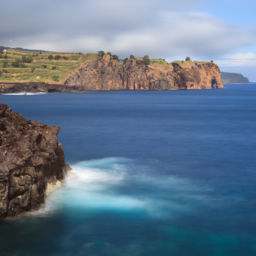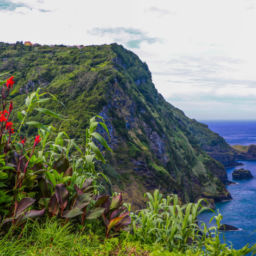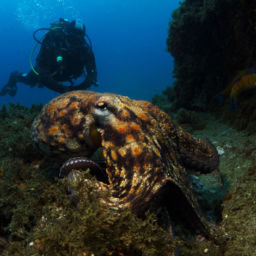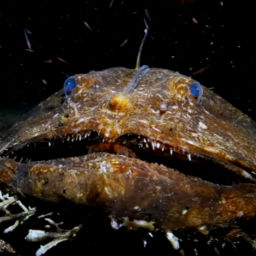Save for the clusters of blue, red and green hydrangeas that decorate the island’s roadsides, the Azorean island of Faial specializes in a barren and harsh beauty. The black-ash landscape of Capelinhos volcano, as well as the caldera at the island’s summit, are stark reminders of the island’s volatile and recent volcanic history. The difference underwater could not be more stark. The steep walls of Monte da Guia Marine Reserve bloom with underwater flora and fauna, and eagle rays congregate in the Atlantic’s cobalt waters.
Speeding out from the harbor at Horta, the headland of Monte da Guia looms. A five-minute trip from Faial’s capital and you have arrived. The old caldera’s steep walls continue underwater. A back-roll entry off the Zodiac and into the clear Azorean water, 68 to 75 F (20-24 C) in the summer months, means a 5mm wetsuit is suitable.
Descending to 80 feet (25 m), a sandy bottom awaits and gradually slopes off to a depth of 450 feet (140 m) toward the middle of the channel between the islands of Faial and Pico. Colossal rock boulders litter the bottom, and provide homes to four species of moray eel — black, brown, fangtooth and Mediterranean. Stingrays and giant dusky groupers call the site home as well. One resident grouper, weighing over 220 pounds (100 kg) resides in the skeletal remains of a tiny, timeworn steel vessel at 82 feet (25 m).
Monte da Guia caverns
Despite the variety of marine life, the marine reserve’s deep caverns are the real highlight of the dive. Swimming 150 feet (50 m) into the vast, dark cavern, small silhouettes begin to take shape in mid-water. Groups of up to 30 eagle rays begin to fill the cave, gliding gracefully mere inches from each diver.
For the most picturesque image, swim to the end of the cavern where the depth reaches 16 feet (5 m) and then wait, turning to look out toward the cavern’s entrance, illuminated in a magnificent blue. Count the black outlines of the eagle rays in the mouth of the cavern with 120 feet (40 m) of visibility.
Heading north
After admiring the scene, exit the cavern and proceed to the exterior. Depending on the tides, you will either drift north (rising tide) or south (falling tide). Both directions hold appeal. Going north, you will pass a pinnacle at 50 feet (15 m), where yellowtail barracuda congregate by the hundreds. A sloping wall on your left side might feature passing bonito and skipjack tuna. Finally, you will reach a sandy bottom, ranging from 15 to 30 feet (5 – 10 m) in a sheltered bay that acts as a marine nursery of sorts. You might spot small octopus, lizardfish and rays hidden in the sand. Look also for common seahorses, clinging to a small rock at 18 feet (6 m). It’s easy to miss these four-inch creatures, as they closely resemble the algae on the rock.
Heading south
Heading south from the cave, the wall will be on your right side but this time extremely steep, dropping to a depth of 100 feet (35 m) below. Large mobula rays, oceanic mantas and bottlenose dolphins sometimes pass the wall, taking advantage of the island’s nutrient-rich waters. Despite the megafauna you might see, the flora along this route warrants most of your attention. Algae and sponges cover almost the entire rock in all shades of the spectrum. The scene resembles a botanical garden more than an underwater landscape. Many nudibranch species also inhabit the steep wall. This dive offers something for everyone with the right conditions, from the macro- to megafauna-lover.
Monte da Guia topside
After the dive, explore Monte da Guia by land. To the east is the beautiful beach at Porto Pim. This is a rarity on these volcanic islands, where ash and sharp lava cover most of the coast. The University of the Azores runs a small aquarium on the slopes of the headland, where you can see many of the resident Azorean marine life. Finally, those interested in the culture and history of the island can visit a whaling museum in Faial, which offers fascinating insight on the whaling industry that ended in 1984.
CW Azores is a PADI and SSI dive resort on Pico Island. The Gulf Stream and varied seafloor topography create ideal conditions in the Azores for rich, abundant and diverse underwater fauna.










